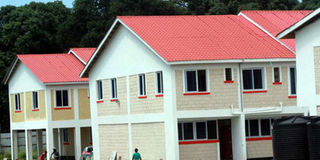Two-bedroom house for Sh800,000? Yes, in Mombasa

The almost complete cheaper and affordable house by the Kenya projects in Mtwapa in this picture taken on 18 August 2015. PHOTO| LABAN WALLOGA
What you need to know:
When the company made the announcement at last year’s expo, it had already received requests from the bedsitter investors to build affordable two- and three-bedroom units. In response, it set up the housing project in Mtwapa, Kilifi County, drawing dozens of home buyers.
Initially, Murithi says, the company started building houses using interlocking blocks and sold the first lot of 25 units at Sh800,000 each as promised, but people started doubting the durability of the houses.
When a Mombasa-based real estate firm announced during an expo last year that it would sell two-bedroom houses for Sh800,000, players in the sector dismissed the people behind it as non-starters and warned that the promise would blow up in their faces.
The expo, organised by MySpace Properties, brought together real estate investors, dealers in home appliances, renewable energy, as well as the banking and insurance sectors, and failure to deliver would have had severe consequences for the company.
But Kenya Projects, also a financial services firm, seems to have done its homework well, if the success it has registered in just one year is anything to go by.
“Looking at the type of investments in the sector, we realised that the middle-income earner has been ignored. Very few people can afford houses going for Sh7 million and above. And don’t forget that only a small fraction of home buyers get access to a mortgage,” says Anthony Murithi, the firm’s projects adviser.
“At the moment, everybody is building luxury homes. The problem is that no one is taking care of the middle-income earner who cannot afford the apartments going for those millions,” he adds.
Lately, developers across the country have come up with luxury homes and apartments targeting the high-end home buyer, with a three-bedroom apartment going for up to Sh50 million.
Murithi notes that, although there is a market for such projects, there is greater demand among middle-income earners, who have been locked out of real estate investment opportunities.
Having started as a Sacco catering for Kenya Ports Authority (KPA) pensioners in 1997, Kenya Projects carved a niche in a market that is regarded as risky, giving pensioners investment opportunities.
“Nobody wants to be associated with pensioners. While banks don’t give them loans, some Saccos are wary about dealing with them. But this market was our main focus,” he offers.
When the company rebranded and ventured into real estate agency in 2002, it invested Sh15 million and built bed-sitters in Mishomoroni, north of Mombasa, and shopped around for what Murithi calls secondary investors.
“These are investors who have limited funds since they cannot get funds from lenders. The bedsitters, which were going for Sh400,000 each, were snapped up within a couple of months, with some people buying up to five units to let,” says Murithi, adding that although they did not make much money because the profit margin was small, they won the confidence of the investors.
When the company made the announcement at last year’s expo, it had already received requests from the bedsitter investors to build affordable two- and three-bedroom units. In response, it set up the housing project in Mtwapa, Kilifi County, drawing dozens of home buyers.
Initially, Murithi says, the company started building houses using interlocking blocks and sold the first lot of 25 units at Sh800,000 each as promised, but people started doubting the durability of the houses.
KENYANS BELIEVE IN QUARRY BLOCKS
“One problem we face is that Kenyans believe in quarry blocks, which are very expensive. They don’t understand the difference between bricks made from soil and interlocking blocks, which are even more durable than the quarry blocks,” he says.
After they resorted to the quarry blocks, the prices went up and the houses are currently going for between Sh2 million and Sh3 million, depending on whether it has a garden and car park. Sector players say the prices are still quite low.
Some clients are also buying two units for Sh1.3 million each, combining them and extending them into the car parks at a cost of Sh1.2 million, so they end up with a five-bedroom maisonnette at a cost of Sh3.8 million.
“I don’t think you can get a five-bedroom house for Sh3.8 million anywhere except here. Home owners are coming up with various designs, but we are flexible and ave no problem with the custom-made versions, so long as they fit into the project,” Murithi told DN2 during an interview at the site.
So far, the firm has sold 300 units within nine months and demand for low-cost homes is very high. Mr Murithi says they are rushing to meet the demand, even as other industry players continue doubting the profitability of their projects.
He says their secret is the goodwill they have with their clients, which means they are able to sell their projects off-plan. For instance, they have sold more than 100 units of three-bedroom units for a project that is set for ground breaking soon.
“When an investor sources for funds from a lender, the interest charged is loaded onto the final price of the units. The investor also has to consider how long the money is going to be tied to the project and if the returns would have been higher had he put the money in another project,” he says.
Mwenda Thuranira, the Chairman of the Kenya Property Developers Associationm Mombasa Chapter, says the firm has innovative ideas that could be exploited to provide Kenyans with affordable housing and should be “replicated across the country.”
“The government should enter into public private partnerships with such investors to bridge the existing gap in the housing sector,” says Mr Thuranira, who is also chief executive officer of of Myspace Properties.





